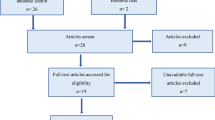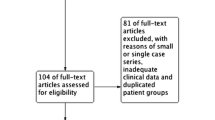Abstract
Aim of the study
Hirschsprung’s disease (HSCR) is known to occur in families. The reported overall incidence of familial cases is 7.6%, with a higher incidence of 15–21% in total colonic aganglionosis and 50% in the rare total intestinal aganglionosis. HSCR is extremely rare in twins. The aim of this study was to systematically analyse the patterns of HSCR in twins published in the literature.
Methods
Electronic databases Pubmed and Medline were screened for relevant articles using the keywords “Hirschsprung’s disease”, “aganglionosis”, “twins”, “monozygotic”, and “dizygotic”. Examining reference lists identified further relevant papers.
Main results
Twelve studies with a total of 18 twin pairs were included in this analysis. 67% twins were discordant. HSCR was found in 24 out of 36 twin subjects (67%), of which 83% affected were male. Rectosigmoid type was reported in 71% of patients, long-segment disease in 21, and 8% presented with a total aganglionosis. Three twin pairs had at least one family member affected with HSCR.
Conclusion
HSCR was found in two-thirds of twin subjects with a male predominance. Rectosigmoid aganglionosis was the most common variant. Disease discordance was identified, where environmental insults were postulated to be predisposing factors to disease expression. Future studies investigating the disease-associated mutations in the already identified HSCR genes should provide insights into the genetic basis of HSCR in twins.

Similar content being viewed by others
References
Badner JA, Sieber WK, Garver KL, Chakravarti A (1990) A genetic study of Hirschsprung disease. Am J Hum Genet 46(3):568–580
Moore SW, Rode H, Millar AJ, Albertyn R, Cywes S (1991) Familial aspects of Hirschsprung’s disease. Eur J Pediatr Surg 1(2):97–101. doi:10.1055/s-2008-1042468
Mc Laughlin D, Puri P (2015) Familial Hirschsprung’s disease: a systematic review. Pediatr Surg Int 31(8):695–700. doi:10.1007/s00383-015-3730-z
Nemeth L, Yoneda A, Kader M, Devaney D, Puri P (2001) Three-dimensional morphology of gut innervation in total intestinal aganglionosis using whole-mount preparation. J Pediatr Surg 36(2):291–295. doi:10.1053/jpsu.2001.20693
Caniano DA, Ormsbee HS 3rd, Polito W, Sun CC, Barone FC, Hill JL (1985) Total intestinal aganglionosis. J Pediatr Surg 20(4):456–460
Parisi MA (1993) Hirschsprung disease overview. In: Pagon RA, Adam MP, Ardinger HH et al (eds) GeneReviews®. University of Washington, Seattle
Amiel J, Lyonnet S (2001) Hirschsprung disease, associated syndromes, and genetics: a review. J Med Genet 38(11):729–739
Moore SW (2012) Chromosomal and related Mendelian syndromes associated with Hirschsprung’s disease. Pediatr Surg Int 28(11):1045–1058. doi:10.1007/s00383-012-3175-6
Bodian M, Carter CO, Ward BC (1951) Hirschsprung’s disease. Lancet 1(6650):302–309
Emanuel B, Padorr MP, Swenson O (1965) Familial absence of myenteric plexus (Congenital Megacolon). J Pediatr 67:381–386
Mohammed AA, Gahukamble DB (2000) Concordant expression of Hirschsprung’s disease in monozygous twins. Saudi Med J 21(2):200–201
Moore TC, Landers DB, Lachman RS, Ament ME (1979) Hirschsprung’s disease discordant in monozygotic twins: a study of possible environmental factors in the production of colonic aganglionosis. J Pediatr Surg 14(2):158–161
Siplovich L, Carmi R, Bar-Ziv J, Karplus M, Mares AJ (1983) Discordant Hirschsprung’s disease in monozygotic twins. J Pediatr Surg 18(5):639–640
Hannon RJ, Boston VE (1988) Discordant Hirschsprung’s disease in monozygotic twins: a clue to pathogenesis? J Pediatr Surg 23(11):1034–1035
Jung PM (1995) Hirschsprung’s disease: one surgeon’s experience in one institution. J Pediatr Surg 30(5):646–651
Sarioglu A, Senocak ME, Hicsonmez A (2000) Discordant Hirschsprung’s disease in monozygotic twins with concordant congenital deafness. Eur J Pediatr Surg 10(3):204–206
Patel RV, Lawther S, McCallion WA (2013) Discordant monozygotic total colonic Hirschsprung’s disease presenting with neonatal isolated ileal perforation. BMJ Case Rep. doi:10.1136/bcr-2013-200743
Fairweather DS, O’Sullivan HJ (1947) Gastric dilatation, megacolon, and idiocy in identical twins. Arch Dis Child 22(112):236–241, 257
Passarge E (1967) The genetics of Hirschsprung’s disease. Evidence for heterogeneous etiology and a study of sixty-three families. N Engl J Med 276(3):138–143. doi:10.1056/NEJM196701192760303
Tam PK, Garcia-Barcelo M (2009) Genetic basis of Hirschsprung’s disease. Pediatr Surg Int 25(7):543–558. doi:10.1007/s00383-009-2402-2
Bradnock TJ, Knight M, Kenny S, Nair M, Walker GM, British Association of Paediatric Surgeons Congenital Anomalies Surveillance S (2017) Hirschsprung’s disease in the UK and Ireland: incidence and anomalies. Arch Dis Child. doi:10.1136/archdischild-2016-311872
Smith WG (1970) Genetic considerations in aganglionic megacolon and imperforation. Proc R Soc Med 63(Suppl):10–15
Lane PW (1966) Association of megacolon with two recessive spotting genes in the mouse. J Hered 57(1):29–31
Stannard VA, Fowler C, Robinson L, Besner G, Glick PL, Allen JE, Jewett TC, Cooney DR (1991) Familial Hirschsprung’s disease: report of autosomal dominant and probable recessive X-linked kindreds. J Pediatr Surg 26(5):591–594
Reyna TM (1994) Familial Hirschsprung’s disease: study of a Texas cohort. Pediatrics 94(3):347–349
Wallace AS, Anderson RB (2011) Genetic interactions and modifier genes in Hirschsprung’s disease. World J Gastroenterol 17(45):4937–4944. doi:10.3748/wjg.v17.i45.4937
Engum SA, Petrites M, Rescorla FJ, Grosfeld JL, Morrison AM, Engles D (1993) Familial Hirschsprung’s disease: 20 cases in 12 kindreds. J Pediatr Surg 28(10):1286–1290
Author information
Authors and Affiliations
Corresponding author
Ethics declarations
Conflict of interest
The authors declare that they have no conflict of interest.
Rights and permissions
About this article
Cite this article
Henderson, D., Zimmer, J., Nakamura, H. et al. Hirschsprung’s disease in twins: a systematic review and meta-analysis. Pediatr Surg Int 33, 855–859 (2017). https://doi.org/10.1007/s00383-017-4110-7
Accepted:
Published:
Issue Date:
DOI: https://doi.org/10.1007/s00383-017-4110-7




